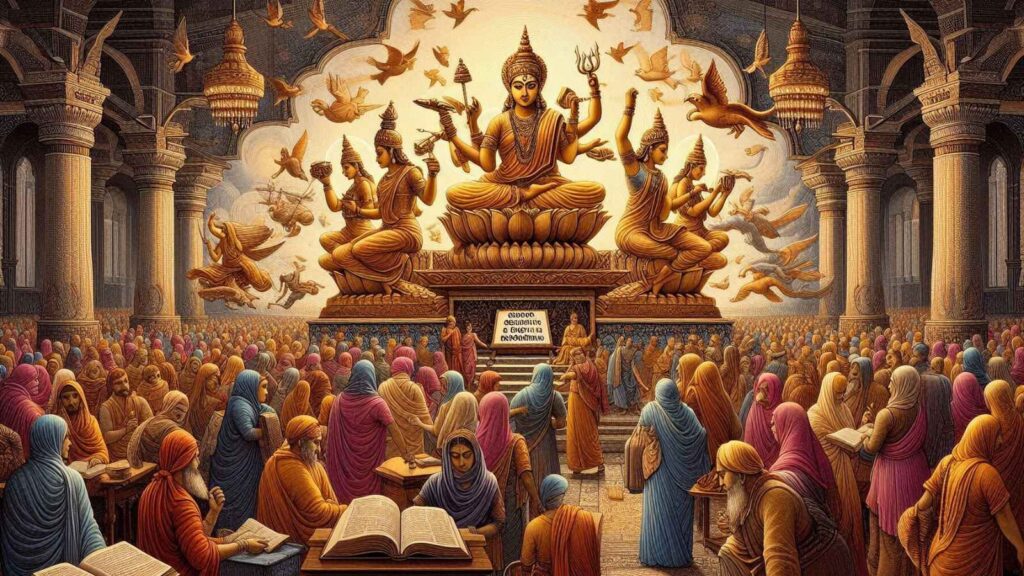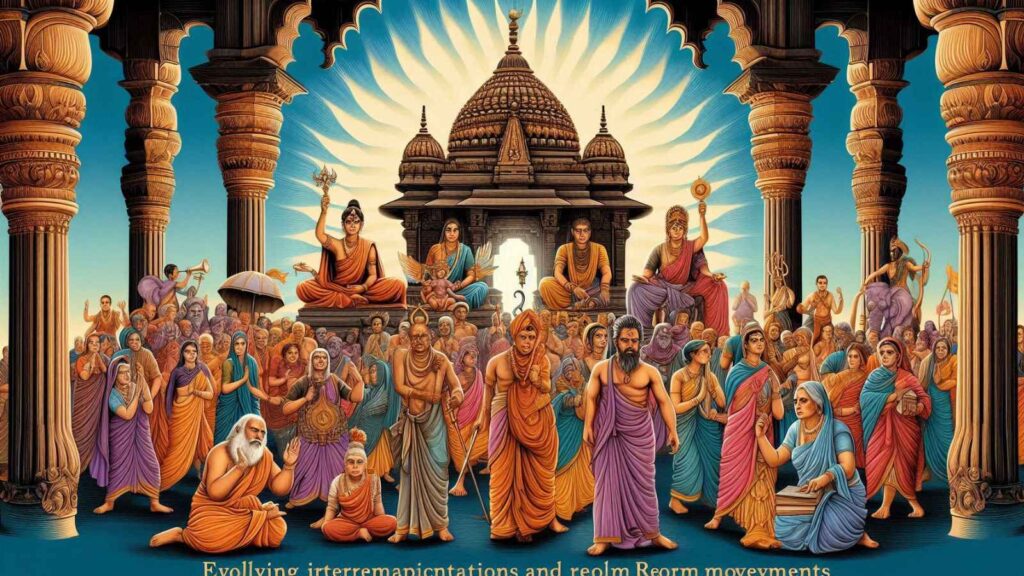Gender and Rights: Evolving Interpretations in Hindu Thought
Introduction
Hinduism, one of the world’s oldest religions, presents a complex tapestry of beliefs and practices concerning gender roles and rights. From the reverence of goddesses like Saraswati and Durga to the patriarchal norms embedded in certain societal practices, Hindu thought on gender has evolved over millennia. This article delves into the historical, scriptural, and reformist perspectives that have influenced gender dynamics within Hinduism.
Read More About sacred texts
1. Vedic Era: Foundations of Gender Equality

1.1 Women in Vedic Literature
The Vedic period (circa 1500–500 BCE) is often highlighted for its relatively egalitarian views on gender. Women participated in religious rituals, composed hymns, and were revered as sages (rishikas). Notable female figures include:
- Gargi Vachaknavi: Engaged in philosophical debates in the Brihadaranyaka Upanishad.
- Maitreyi: Discussed metaphysical concepts with her husband, Yajnavalkya.
The Rigveda contains hymns attributed to women, emphasizing their intellectual and spiritual contributions .
1.2 Concept of Ardhanarishvara
The depiction of Shiva and Parvati as Ardhanarishvara, a composite of male and female halves, symbolizes the essential unity and equality of genders in cosmic functions .
2. Post-Vedic Developments: Emergence of Patriarchal Norms

2.1 Influence of Dharmashastras
Texts like the Manusmriti introduced more rigid gender roles, emphasizing women’s subservience to male authority throughout their lives. While some verses advocate for women’s protection, others restrict their autonomy, reflecting a shift towards patriarchal structures .
2.2 Bhakti Movement: A Counter-Narrative
Between the 7th and 17th centuries, the Bhakti movement emerged, emphasizing personal devotion over ritualistic practices. It provided a platform for women saints like:
- Mirabai: Expressed deep devotion to Lord Krishna through poetry.
- Akkamahadevi: Advocated spiritual equality and challenged societal norms.
These figures challenged patriarchal constraints and emphasized direct, personal experiences of the divine.
3. Colonial Era and Reform Movements
3.1 Social Reformers and Women’s Rights
The 19th and early 20th centuries witnessed significant social reforms aimed at improving women’s status:
- Raja Ram Mohan Roy: Campaigned against sati and child marriage.
- Ishwar Chandra Vidyasagar: Advocated for widow remarriage and women’s education.
Movements like the Brahmo Samaj and Arya Samaj played pivotal roles in these reforms, emphasizing a return to Vedic principles that upheld gender equality .
3.2 Pandita Ramabai’s Contributions
Pandita Ramabai, a scholar and social reformer, highlighted the plight of women in orthodox Hindu society. She established institutions for widows and emphasized the importance of women’s education .
4. Contemporary Perspectives and Challenges
4.1 Legal Reforms and Women’s Rights
Post-independence India has seen several legal measures aimed at promoting gender equality:
- Hindu Succession Act (1956): Granted daughters equal rights in inheritance.
- Prohibition of Child Marriage Act (2006): Aimed to eradicate child marriages.
Despite these laws, implementation remains a challenge, especially in rural areas.
4.2 Women’s Participation in Religious Practices
In recent years, debates have arisen over women’s access to religious spaces:
- Sabarimala Temple Case: The Supreme Court’s 2018 verdict allowed women of menstruating age to enter the temple, challenging age-old traditions .
Such instances highlight the ongoing tension between tradition and modern interpretations of gender rights.
5. Intersectionality: Caste and Gender
Gender dynamics in Hinduism cannot be examined in isolation from caste. Dalit women, for instance, face compounded discrimination. Movements advocating for their rights emphasize the need to address both caste and gender-based inequalities .
6. Global Diaspora and Evolving Practices
Hindu communities worldwide are reinterpreting traditions in light of contemporary values:
- Trinidad and Tobago: Activists are pushing for the inclusion of women’s occupations on Hindu marriage certificates, challenging colonial-era norms .
Such efforts reflect a broader trend of adapting Hindu practices to promote gender inclusivity.
7. Philosophical Underpinnings: Dharma and Gender
The concept of dharma (duty/righteousness) plays a crucial role in Hindu thought. Traditionally, women’s dharma was linked to roles as daughters, wives, and mothers. However, modern interpretations emphasize individual dharma, allowing women to pursue spiritual and personal goals beyond traditional roles .
8. The Role of Education and Empowerment
Education has been a vital tool in challenging patriarchal norms. Initiatives promoting women’s literacy and higher education have empowered many to question and redefine traditional gender roles within Hindu society.
9. Future Directions: Towards Inclusive Practices
The journey towards gender equality in Hinduism involves:
- Re-examining Scriptures: Encouraging interpretations that highlight egalitarian principles.
- Promoting Female Leadership: Supporting women’s roles as priests, scholars, and spiritual leaders.
- Community Engagement: Fostering dialogues within communities to challenge and change discriminatory practices.
Conclusion
Hinduism’s perspectives on gender and rights have undergone significant transformations, influenced by scriptures, societal changes, and reform movements. While challenges persist, ongoing efforts by individuals and communities continue to push towards a more inclusive and egalitarian interpretation of Hindu thought.


